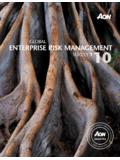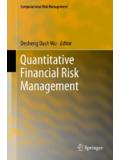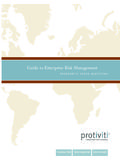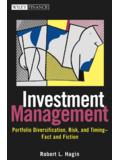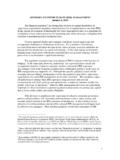Transcription of risk management in insurance industry - Riskpro India
1 1 A Systematic Approach to Risk management : insurance industry By Shriram Gokte Background insurance companies are in the business of taking risks . Worldwide these companies write policies that deal with specific risks , and in many cases, even underwrite exotic risks . As a direct corollary, therefore, insurance companies should be good at managing their own risks . However the truth is a little far from that! Most insurance companies are very good at assessing insurance risks but are not very good at setting up structures in their own home to manage their own operating and business risks .
2 As an emerging need from the credit crisis, IRDA issued a set of guidelines on corporate governance in 2010,1 which contained a reference to the setting up of a mandatory risk management committee (RMC). The RMC has to lay down a risk management strategy across various lines of business, and the operating head must has direct access to the Board. However, IRDA left it to the companies to work out the details of how risk management functions were to be suitably organized by them given the size, nature, and complexity of their business.
3 But that should in no way undermine the operative independence of the risk management head. Because of this leeway, most of the Indian insurance companies have given risk management responsibilities to one of the actuaries, which is not a very strong move toward independence. Today it is well recognized that sound management of an insurer, as for other financial sector entities, is dependent on how well the various risks are managed across the organization. In this article I have described how ideally should insurance companies manage their various risks .
4 1 IRDA s guidelines on Corporate Governance for insurance Companies 2 Risk Drivers In an insurance company, the cash flows are organized along two streams: a) Inflows premiums, investment income, refunds, and so on and b) Outflows claim payments, reinsurance premium, agent remuneration, salaries, interest and dividends to investors, and so forth. Thus, risks could be considered along these two flows. In addition, insurance products rely on models dealing with longevity/mortality, morbidity, economic conditions, or market conditions.
5 There is a large risk that any of these assumptions or models could be incorrect, leading to first the pricing risk (that price charged was incorrect) and then the solvency risk risk that arises from inadequate reserves, and company runs out of capital. As many insurance companies have large fixed income holdings or equity position, there is also credit risk and market risk associated with their investment portfolio. Moreover, the processes, people, and systems of an insurance company are also exposed to risks .
6 These are operational risks and are present throughout the company. Additionally, like other corporations, an insurance company is exposed to other strategic risks , such as liquidity, reputation, legal, business planning, and so on. The time lag between the selling of an insurance coverage and the claim payments can be extremely long. This lag makes insurance a particularly difficult business to manage. There are also a variety of cultural reasons that complicate insurance risk management . For example, there is a perception by some insurance managers that the insurance business is strictly an underwriting game.
7 This essentially means that if an insurance company underwrites the right risks at the right prices, the other key insurance activities ( investment , claims handling, reinsurance, and so on) can take care of themselves. In this situation risk management obviously takes a back seat. Risk Framework A good risk framework should have a strong governance structure so that the board and the management should know how risks are being managed. This involves appointing a chief risk officer (CRO) for risk management and the organizational culture too should support it.
8 In large companies, it is common to form a separate risk management unit, staffed by a multi-disciplinary team. The work of this team is typically facilitated by 3 designated persons in each of the various departments, such as underwriting, legal/compliance, actuarial, finance, marketing and sales, policy servicing, claims, IT, and so on. The management should always be aware about the dangers of undermining the independence of the department and should ensure that the risk-taking and risk monitoring roles are independent.
9 To ensure this, there are a few well-known frameworks available such as ISO 31000 risk management standard and the COSO There is another framework used by S&P and A&M Best in their ratings as well. Few of the governance structures are given below. Figure 1 An ERM framework (based on COSO, ISO 31000 & S&P frameworks) A CRO should ensure that risk management in the organization is centralized rather than being carried out from silos. He should functionally report to someone like the risk & audit committee while administratively he could report to a CxO, such as the chief financial officer (CFO).
10 This gives the CRO the independence and ability to ask tough 4 questions to the top management . Structurally, there are several choices on where the CRO should be placed in the organization. Franchise vs Policyholder interest To appreciate the risk environment better, a CRO should understand the nuances among the policyholders interests, franchisee interests, and other stakeholders interests. The policyholder interest represents the objectives behind insurance policy purchases by policy buyers; regulators enforce the protection of policyholder s interest.

